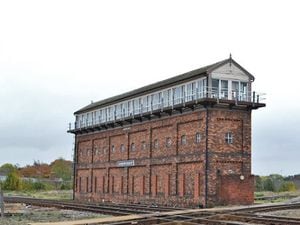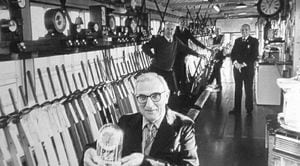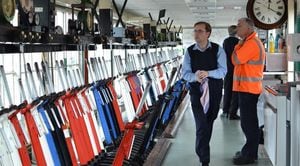Historic Shrewsbury signal box in TV appearance
A historic railway signal box in Shrewsbury has featured on TV to show how it still helps keep the railway network on track.

The Severn Bridge Junction, the world's largest working mechanical signal box, was visited for the latest episode of The Architecture of the Railways Built on Yesterday.
Presenter Tim Dunn explored the Grade II-listed building and spoke to signallers, who are doing one of the last steam-age jobs on the network.
Severn Bridge Junction, which opened in 1904, will remain open for the foreseeable future, although Network Rail is updating signalling across Britain.
Signallers like Jamie Green remain crucial to Shrewsbury, ensuring all trains pass safely through the station without state-of-the-art technology.

The team has computer systems and paper sheets as back-up but typically works from memory, pulling 180 levers in a specific sequence according to the platform a train should arrive at.
Jamie says: “It’s very satisfying the way it connects together. It’s like a mechanical jigsaw puzzle.”
Two railway operating companies – the London & North Western Railway and the Great Western Railway – worked together to build five lines converging at Shrewsbury despite rivalry between them.
They competed to connect South Wales' coal and materials supplies with the industrialised regions of the Midlands and North West, and to transport passengers between Liverpool and London.

Shrewsbury station, which opened in 1848, was historically known as a hub of significant commercial activity. In fact, an article written by JT Lawrence for Railway Magazine in 1905 described the station as a “switch board”, with claims that more traffic was “interchanged and redistributed at Shrewsbury than even at York”.
In 1905, Lawrence praised the station’s signalling system, noting its guard rails. They run along the track in areas with restricted clearance, such as bridges and tunnels, to keep trains’ wheels aligned in case they come off the line.
He said: “The lines approaching the station are laid out in curves of somewhat short radius, and the system of guard rails is deserving of notice. Instead of being in short lengths, as is frequently the case, they are in apparent continuity with the respective facing points, and any derailment seems to be impossible.” They remain in place today, specifically because of the tight curvature around the station.
Severn Bridge Junction bears no resemblance to the modern rail operating centres across Britain today. From the top floor of the box, visitors can see Shrewsbury Castle to the south and, in clear weather, Shropshire Hills on the horizon. “Here, a sunny day isn’t wasted," added Jamie.
To see the episode visit uktvplay.uktv.co.uk/shows/the-architecture-the-railways-built/watch-online





